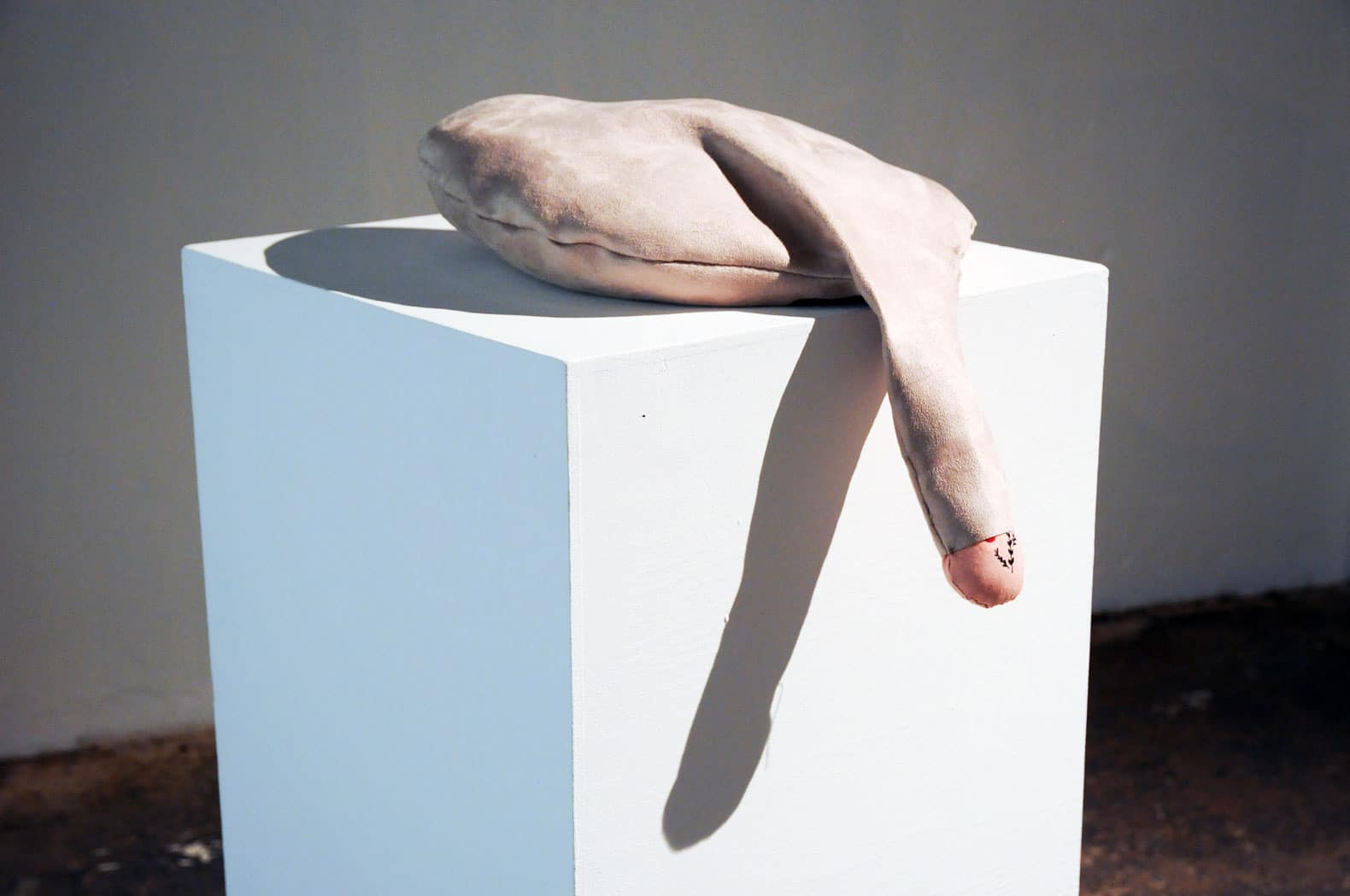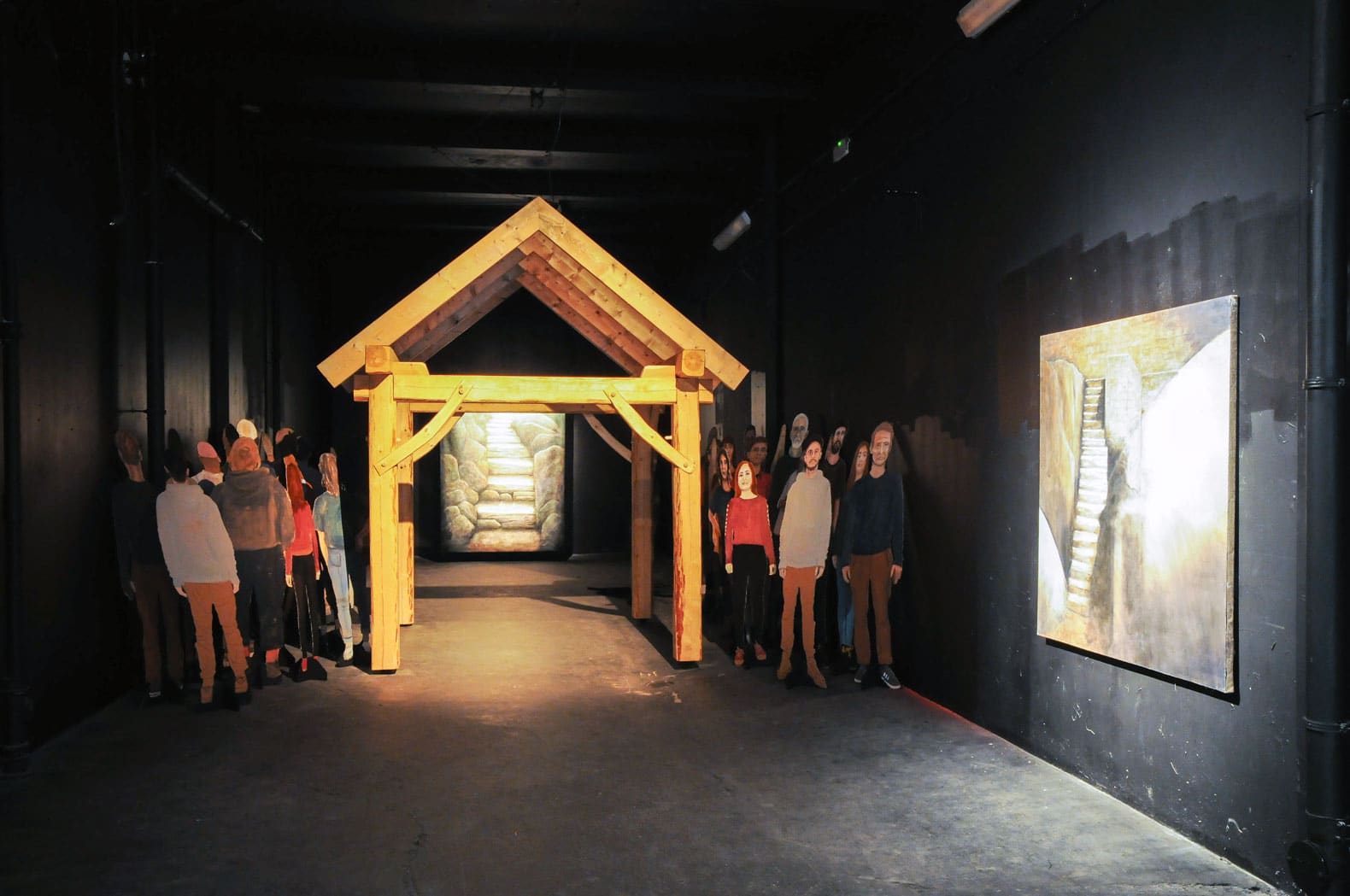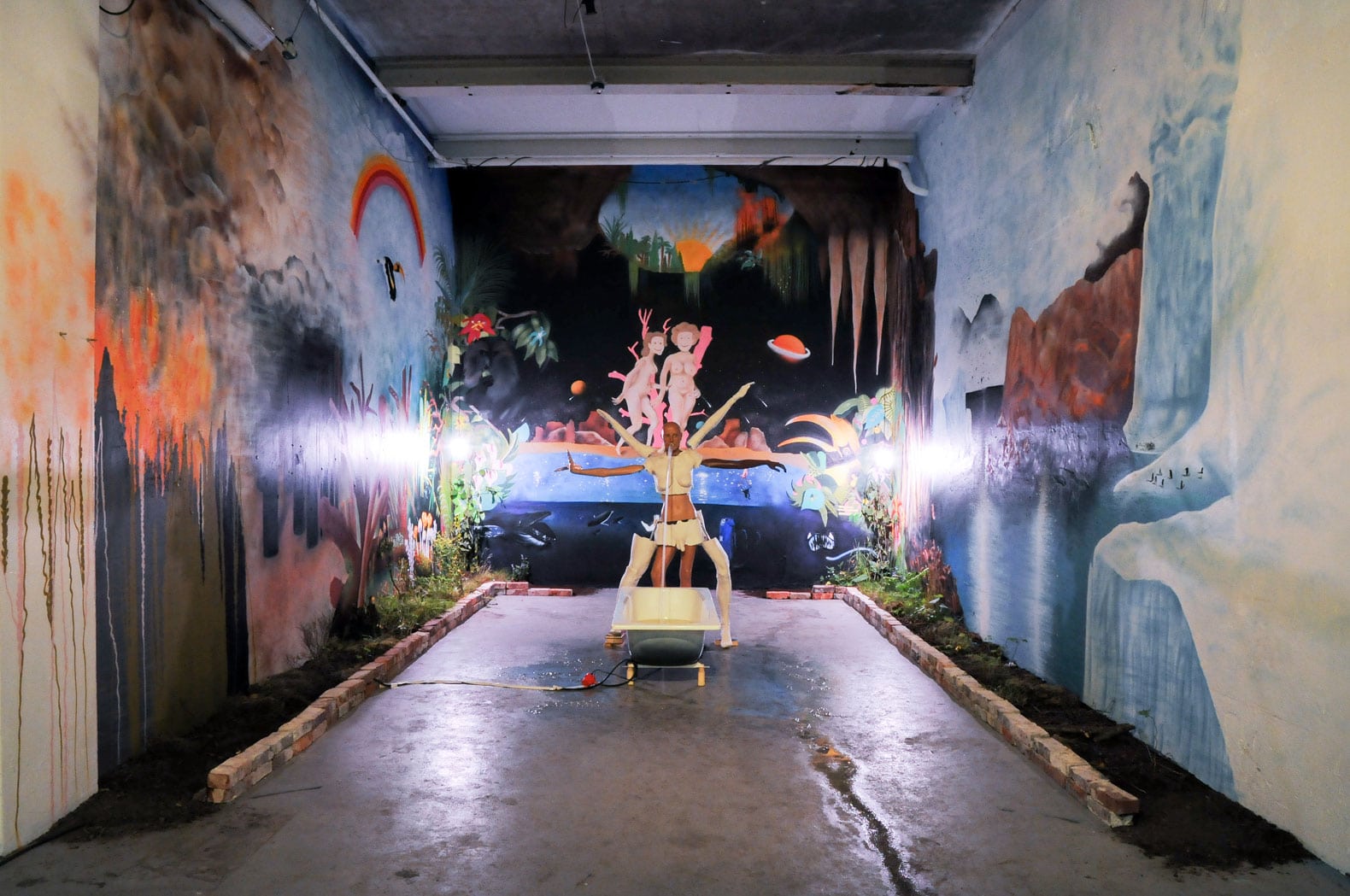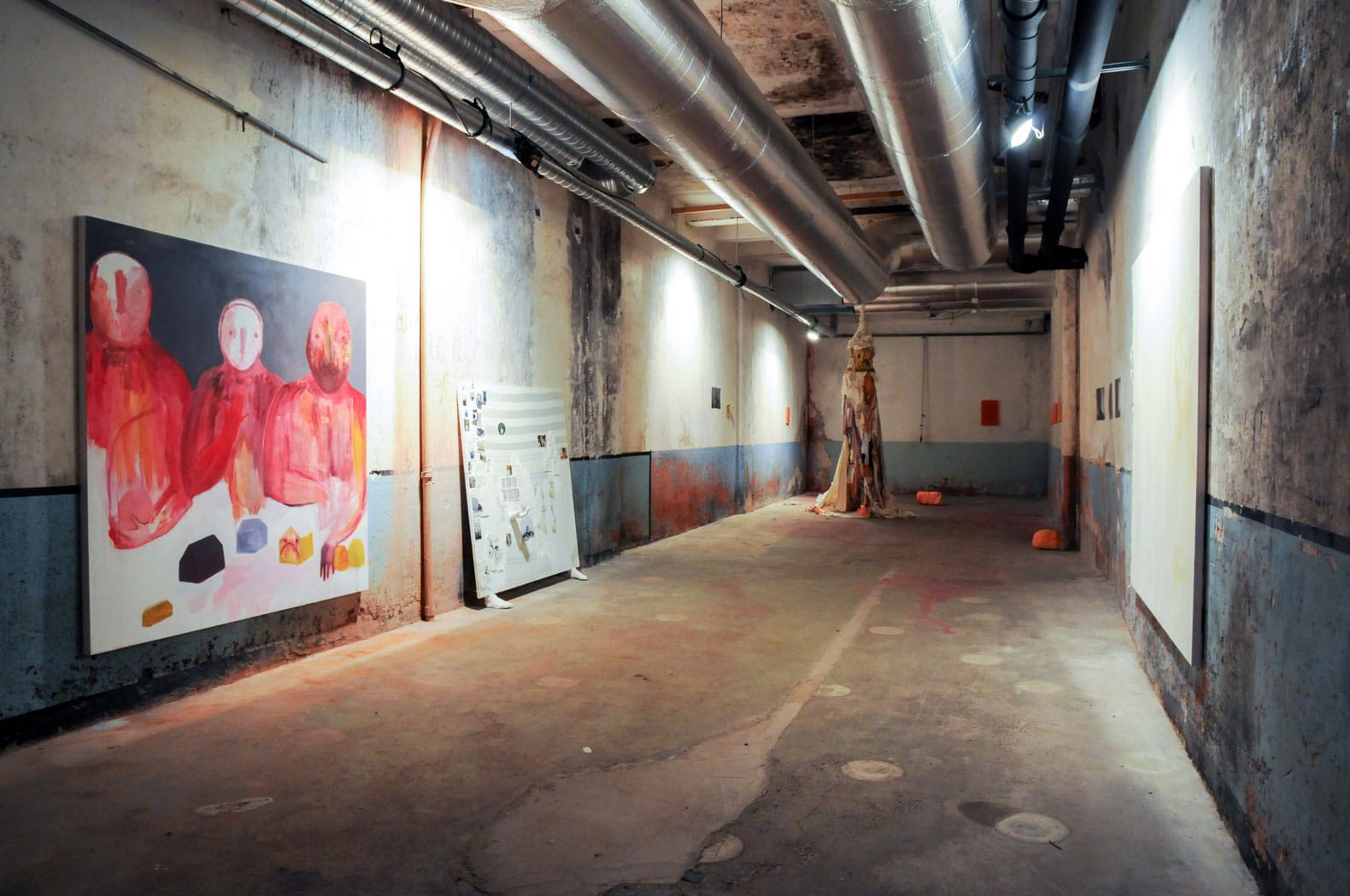To walk into the KiR Graduation Show at the ground floor gallery of Tou Scene was to be immediately distracted by the character of the place. The gallery looked dated with peeling walls and signs of use. A mix of light sources made it a shadowy cave, partly secluded from the rapidly changing coastal elements outside. The whistling northerly wind nevertheless managed to squeeze its way in. It was less the history or meaning of the place that made it so dominating, but its texture and temperature. It presented an almost ghostly energy, trembling in a way that white-wall galleries do not. I wondered what was in this energy and how the art shared, distributed, defined or defied it.
I conceive of this essay as an extension of an hour long Walk and Talk that I was invited to lead in early June with the principle of “the phenomenology of encountering art” in mind. 1 My approach was to share my spontaneous and sensible experiences of the artworks. This essay is therefore guided less by the intention to explain or analyse, but by a motivation to dilate the borderlines that briefly defined my encounter with each work, and to allow the doorways into the art to remain open.
- The Walk and Talk for the public took place on June 6, 2019 in Touscene. It was organized by the pinciple of Kunstskolen i Rogaland John Øivind Eggesbo and co-presented by Contemporary Art Stavanger (CAS). I am grateful for the support of CAS and KiR to be there, for the chance to share my observations and have a dialogue with some of the graduating artists at the event. “The phenomenology of encountering art” was a prompt suggested by the director for the event.
It is also a longing on my part to extend the experience of being touched by that special dusk of the early summer in the northernmost part of the world that I have never been, of communing with the many realities enabled by art. My aim is not to be exhaustive, but rather to tap into the incomplete, which is not a lack, but a fundamental human experience. As American philosopher Maxine Greene succinctly puts it, "Only human beings can experience incompleteness, the gap between what is and what might be. Only human beings can fill the gap by moving out in search of meaning and transcendence, moving out to change their world. The focus must remain on the human being, on his or her achievement, his or her choice." 1 In that which is incomplete, we keep walking.
- See Maxine Greene, Landscapes of Learning. New York: Teachers College, Columbia University. 1978.
Material encounters
The gallery at Tou Scene is made up of eight elongated halls (roughly even in size), one corridor connecting the entrances of these halls, and an entrance lobby. Most halls present the works of two artists. Two present one artist’s work each.
The entrance lobby is the only part of the venue touched by natural light, which brings out the glisten of dripping water in Leif Ole Stampa Johannsen’s kinetic sculptures. These electronic machines made of fibreboard and plastic don’t aspire to be “smart” in their function or posh in their looks. The artist employs his knowledge of engineering and his passion for noise (in music and beyond) to stage a small-scale protest against high-tech dreams. The fragile balance each machine seeks to uphold is a testimony to how glitches and imperfections that are not permitted in mass produced consumables can be re-appropriated for an alternative vision: the beauty and integrity of irrelevance. It is no small thing to lend attention to irrelevance, I recall learning from musician and composer Kenneth Gaburo. 3 While Gaburo’s context is music, I find his claims especially relevant to Johannsen’s work. Gaburo says it is difficult “to maintain a system of irrelevance without appearing to be innocent, naïve, bitter, cynical, defensive, or just plain stupid.” And yet he still chooses to articulate its value. Little might appear to be at stake, he claims, but “the assertion of every irrelevant music is that it has no larger funktion [sic] until a proper environmental system can be created in which it is to say that ‘it can live’.” Whatever this “system” is, it is not already there. As a set of relations, it is to be made by the artist. Gaburo tentatively concludes with a rhetorical question, “It is rather like asking: ‘Who shall develop your home, a developer, or you?’” The staged spontaneity of the installation and the confidence in Johannsen’s gestures are compelling responses to Gaburo’s question.
- Kenneth Gaburo, The Beauty of Irrelevant Music. Lingua Press. 1970/ 1974. Available also as open source online.
Jonas D. Johansen’s paintings, wall-mounted in salon-style, are a productive juxtaposition to Johannsen’s installation – safeguarding, observing, lending attentive ears to it. Together, the artists’ visions become undulating rhythms. In a bright palette comprising varying hues of red, orange, yellow, green, and an occasional brownish crimson, his paintings celebrate a polyphony of flora and fauna, human figures enmeshed as if continuous with their way of being in the world, singing around Johannsen’s quiet, subdued, slow machines. For instance, one painting portray several human figures whose faces are blurred but depicted in postures that suggest attitudes and comportments. The number of figures remains unclear, for some of them carry phantoms of their own bodies on their backs, multiplying. I am particularly drawn to one portrait that shows a predominantly yellow face in the foreground, with two smaller faces either protruding from it or metamorphosing into it. The face could be read as physical contortion; it could also be read as a psychological labyrinth rich with desires and passions, changing constantly in response to the world around it. It is a blooming flower bursting with life and hope, expressing a tinge of defiance, which the artist affirms in the endless and varying movements of his strokes. “You are interested in infinity – the infinite layers of who a full human being can be,” I tell Johansen in the Walk and Talk. In hindsight, I would say he shows a capacity to free his gaze in order to access the possible worlds that make up a face, any face; it is a capacity to empathize.
Body encounters
Marie Saure’s mixed media installation is in Hall 7. Two videos are mounted on the wall, adjacent to each other. One of them shows the artist with her head veiled with a thin, white scarf. She swims out into the water in a straight line, slowly and without hesitation. The sky and water are grey. I wonder what kind of border she is identifying and desiring to cross. The other video shows patches of fluorescent green light scattered over a dark image that seems like an underground well or waterway. It is not clear where the green comes from – it could be read as the natural phenomenon of bioluminescent marine creatures. It could also be read as an unnameable otherworldly glow, haunting the place. Another part of the installation consists of mattresses laid on the ground. In ordinary domestic life, the mattress is a site of rest and comfort. Here, it is also a site of contested power. Small, stuffed human figures lie on the smaller mattresses, facing up, spread eagle. Each mattress holds one figure – as if they were custom-made for each other. It is not clear if they are rendered impotent, getting some much needed rest, or surrendering. On a bigger mattress at the corner, small round embroidered objects bulge out. Saure said they were nipples. For me, these objects in varying sizes grow out of the mattress as wild vines do – a register of nature’s vitality and freedom. As a whole, I find a challenging emotional landscape of pleasures and fears, fulfilment and resentment – all of which takes courage on the artist’s part to address.

In another hall, Jasemin Telle’s soft sculptures are precise and composed artistic gestures: simple, witty, and made with a lot of love. One could say that the two cushions on pedestals are for hugging and cuddling, though paradoxically, they are also presented as precious objects not to be touched. In the Walk and Talk, I shared with the participants how they reminded me of internal organs – a kidney or a gall bladder, animal or human - despite having been told: “They are dicks and balls.” I find Telle’s erotics more subtle than literal. Her sculptures are situated between desire (for inviting caress) and disgust (for suggesting decay). They could also be objects of protest: phallus on strike. It makes me think of Louise Bourgeois holding the sculpture Fillette (1968) in her portrait by Robert Mapplethorpe. Commenting on the phallic appearance of Fillette, Bourgeois said, “It is not a phallus. This is what people say and what it is is completely different…The piece is called Fillette (1968). Fillette means une petite fille [a little girl]. If you want to indulge in interpretation you could say that I brought a little Louise…It gave me security.” 4 Bourgeois’ gesture is multiply subversive: first, in exploding the size of the phallic into that of a human torso, while naming it intimately as something little and infantile, she reorganizes the terms by which sexed bodies are conventionally circulated – how size matters or not, for what purpose, in whose body, and in which relations. She is making a claim to the act of “being photographed”, refusing to be passive, remaining in control. I can imagine Telle discerning these gestures of excess in order to traverse established boundaries: what sexual organs become when they fail to deliver what conventional imagination want them to.
- I would like to thank Beth Grossman for reminding me of the relevance of Louise Bourgeois in interpreting this particular piece of work. Bourgeois’ words are cited from Louise Bourgeois, Destruction of the Father, Reconstruction of the Father: Writings and Interviews 1923 – 1997, ed. Marie-Laure Bernadac and Hans-Ulrich Obrist. Cambridge, MA.: MIT Press. 1998: 202.
Frida S. Rangnes collaborates with Ingeborg Pedersen to present a comparable affective landscape in Hall 8. On the walls are a series of wax sculptures – some of the pieces are complete rectangles, while others have been partly melted. I call them “sculptures” despite the way they also present themselves as canvases. I see them as spatial interventions on the walls; at work in their own materiality rather than in the materiality they carry (like ink or acrylic on canvas). The wax is moulded as three-dimensional forms growing out of the walls. The sculptures evoke a sense of passing time, of objecthood in transition. On a wall adjacent to the sculptures is a series of photographs. They depict faces concealed in patches of tape or paper, leaving only the eyes and mouth uncovered. Should they be read as faces wounded, by coercion or by choice, with masks for protection? Or as faces asserting their right to be private, with masks as declarations of boundaries that no one should infringe? Whichever way, they address the limitations of visible identity markers as modes of access to the lived reality of a human life. The masks equalize – judgement from the outside based on stereotypical social identifiers must be suspended.
These faces are met with starkly different ones in a painting placed on the diagonally opposite wall. The red, round faces are like giants compared to the masked ones, clothed in angst rather than tape. In both their strength and vulnerability, they speak to our need to commune and connect. It seems as if they were caught in a moment of trembling, which contrasts with the stillness of a tent hanging nearby. Still provisional, but not idle. It is a shelter willing to change its shape to envelop and embrace any human body. The artists had the idea of doing a performance with it, and indeed, a shelter that is moving could augment the layers of meanings the entire installation works with: an attempt to shift the rigidity of boundaries that have brought fear, and requires care and a walk along other possibilities in life to be transformed.


The utopic in the social
While some artists draw attention to individuated modes of inhabiting space, others propose shared spaces for immersive experiences. Bjørn E. Eriksen uses the entire Hall 3 to suggest a path towards enlightenment, without being clear on whether it is religious or secular, intellectual or of other kinds. A wooden hut stands at the center of the hall. The hut is open on two sides, functioning like a passageway. Cardboard cutouts of human figures, painted in realist style, are lined up on the left and right side of the hut. Some of them are facing the front, others have their backs turned. At the end of the hall are two paintings of a flight of steps leading up to a light source. The installation as a whole is theatrical, as if a stageset for a rite of passage open to all. The visitors become its actors. We, from wherever we are, whoever we are, are invited to activate it by situating it in our lives, giving meaning to this generic passage. I am not sure if the human figures are necessary – it seems to me without them, the solitude that comes with the decision to walk towards the light or not could be augmented. But it is also possible to think of the artist as easing an otherwise challenging lone journey with care and support from fellow humans – at least imagining them.
Joachim H. Svendby offers another immersive experience in a different visual language. A hybrid, multiply gendered body spits water into a bathtub. S/he is enveloped by a mural depicting flowing streams, lush trees and pastures, naked human figures…as if civilization has returned to an ordinary state of nature. It could mean paradise for some, but could also be a depiction of exclusion as the fictive space is a habitat for human bodies with white skin. The hybrid figure is indifferent to it, or hesitant to look, or is forced to turn their attention away from it. In the midst of the mural, the figure is a counter monument: it is in remembrance, but also questioning the place of memory in the present, a mindless and repetitive activity that has no past to refer to. The simultaneous configuration of ruins and the utopic give rise to a tension, an unresolved ambivalence. I imagine how the current organization of the components in space could be developed further so that it is less approached as a point in the centre (the figure) and a plain in the periphery (the mural), but through lines that construct connections between visual and tactile details, and that work more on the fluidity between reality and idealization, highlighting the complexity of the artist’s struggle.
In the final hall?, Jonathan Bland sets up an installation with paintings of Stavanger houses. Instead of being mounted on the walls, they stand like hoarding commonly seen in construction sites in cities in the world. They become a route back in time – to walk through them is to reach a reading room where dated news clippings and architectural drawings of old Stavanger houses are exhibited. Together they tell stories of the past and the present. I asked the artist what impressed him most when he was going through the municipal archives on the buildings and street plans of the city. He said, “The architectural drawings.” I didn’t have the chance to find out more about why, but in hindsight, I wonder why this preference, or perhaps the instinct of the artist, is not more discernible in the work, and what might happen if less weight was placed on the paintings as hoarding. I speculate that this may have to do with thinking in terms of rhythm in space – complex decisions the artist has to make on what and how a visitor directs his/her gaze and body in situ. This may also have to do with the question of finding hope, despite loss. The dignity given to the houses may have turned them more into memories or impossible realities, than abstractions that leave room for envisioning the future. As I shared my thought with Bland that the work could use a context as public art in the streets of Stavanger, I had the Valberg Tower in mind. I wondered if Bland’s houses might sound like the wooden steps in the tower. I wonder if the evocative could also play a part in giving life to the documentative.
for now, a small conclusion…
My encounter with the show began with the ghostly energy that emanated from the space itself. I walked out informed by a vision of art as always already immersed in and responding to the risks of life, manifested as space and other conditions that regulate but also liberate the art. This perspective is not always easy to come by: art schools are often quick to align graduation shows with careerism, commercialism, and corporatism. If “rising stars” for the art market are already identified, experimentation, uncertainty, and questioning might be less encouraged. It requires trust and confidence to work with an alternative vision, both from the school and the artists themselves. I realized that it was not only a graduation show I was looking at, but a readiness of art to graduate into a life that is always already––bluntly, quietly, stubbornly––there.
afterword
It’s been two months since I finished a draft of this essay. Returning to it now, I wonder about the artistic freedom manifested in the ways KiR artists engage with the world and the kind of freedom we seek in Hong Kong. As I rework this essay, the wave of protests that began in June in Hong Kong this year continues. It has not been easy coming back to the quietude of the show. While I see nothing explicitly political in the KiR graduation show––not as any political contest between a ruling power and the people––I hear dissenting individual voices against multiple systems that constitute oppression – patriarchy, capitalism, compulsory heterosexuality, and technological determinism, which are situated in the political too.
In Stavanger, an art practitioner asked me many questions about Hong Kong, with care, wisdom, and curiosity. One of the last things she said was, “I am free in Norway, so I can only imagine [your unfreedom].” I take her words to heart. The flip side for me is that I may not have “known” freedom, but it is useful to think and act as if I do, so that a better world can be imagined.
*I am grateful to CAS for their support and their valuable comments on this essay. Any error is strictly mine.
Yang Yeung is a writer of art and an independent curator. She founded the non-profit soundpocket in 2008 and is currently its Artistic Director. In 2015, she started independent project A Walk with A3 located at a back alley in Causeway Bay in Hong Kong to support the right of art to be in the streets and right of pedestrians to encounter art as a daily experience. Currently Yeung is a member of the international research network Institute for Public Art and contributes research writings on place-making public art projects regularly to the network’s conference and archive. She is member of the independent art critics collective Art Appraisal Club (HK) and the International Art Critics Association (HK). She is also Councilor on the board of Make A Difference (MaD), a regional platform based in Hong Kong that encourages social innovation and creative change-making for good. She was awarded the Asian Cultural Council Fellowship in 2013-14. She was selected to participate in the UNESCO training workshop on the 2005 Convention on the Promotion and Protection of the Diversity of Cultural Expressions in 2018. She currently teaches classics at the Chinese University of Hong Kong.


